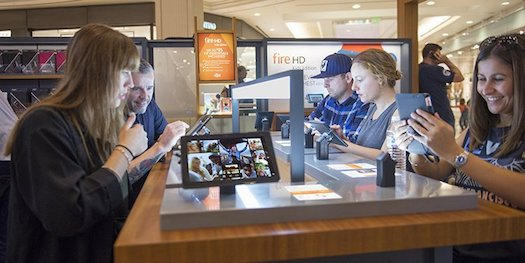Retail Needs to Get it’s Groove Back

Apple welcomes customers to its first store in Taiwan in July. Photo courtesy: Apple
Is retail dead? This became the crux of the matter when I found myself invited to pitch in front of a leading retailer at the Advanced Technology Development Center (ATDC) at Georgia Tech. It was an exciting opportunity that was dulled when the name of the retailer was revealed. They are losing market share to Amazon, the big elephant in every conference room discussing supply chain topics.
This retailer was on a downhill slide, shutting multiple store locations. There are two ways to look at this situation. I could figure that it was a waste of time doing this pitch. The other was to try to turn adversity into opportunity. You can guess which approach I chose.
Part of what led me to this decision was a distinct retail experience from my past. In those days, I saw a Kenneth Cole shoe at a local retailer. My salary was sparse, so I had to plan for the purchase, and wait for a sale. Finally, I got a coupon after about six months, and I was so excited I woke up early to go to the store. I tried it on and it was beautiful, a Kenneth Cole Simplicity in burgundy. I presented the shoes and my coupon to the clerk who told me that the coupon wasn’t valid for my purchase. I left the shoes behind at the store because:
- I felt betrayed by the fine print.
- It felt like a bad deal without the discount.
That was the last time I shopped with that retailer, even though I walked by the store a hundred times. For me it was shoes, but I’m sure we could point to a similar example for just about any electronic gadget or gizmo around.
My takeaway, though, was that all the talk of online killing retail may not be completely true. If retail is sick, it may be that they are not taking care of business. This adversity may be an opportunity to turn it around, come out bigger better and stronger.
Besides, if retail is dead, why are Apple stores filled with people all the time? In fact, just this summer, the company opened its 101st retail location in Taiwan. Plus, there’s no argument that Apple stores are simply cool, with a modern club vibe full of glass. I’ve spent some nice evenings with my daughter checking out the newest devices, listening to music, trying out games and more. People used to window shop in malls, and now they are doing that same thing at the Apple store, since technology is such an important part of our lives.
Apple welcomes customers to its first store in Taiwan in July. Photo courtesy: Apple
Our world is being transformed by technology, and retail isn’t any different. Technology is driving changes there as well. Retailers who hope on board this trend in smart ways, and incorporate technology into their stores, are the ones that are going to survive. Even Amazon is hopping on board, and opening futuristic stores that give customers a chance to get up close to technology and be engaged in cool ways.

Photo courtesy: Amazon
Retail is changing in a big way—and this new breed of retailers has several elements:
- Retail: Selling products that solves consumers’ problems and lend a helping hand to solve their problem.
- Community: The brand engages customers, not just in the store but on social media, to build a community or tribe that makes the world a better place. Consider the Life is Good brand that has made a name and grown with this sort of effort.
- Consultation: Selling is changing. Consumers are well educated today and they know exactly what they want even before they walk into the store. They want help solving their problem. They want to find products and brands that deserve loyalty.
- Tools: Today’s retailers need the right tools to make the above happen:
- Media: Telling relevant stories to engage the consumer with a problem solving approach in channels relevant to the targeted consumer segment
- Technology: Highly targeted and personalized to solve individual pain points/problems. This might be social media, email, relevant apps, or analytics.
The retailers that don’t understand this are the ones that are going out of business.


 1. Increases EPP, using budgeted line items.
1. Increases EPP, using budgeted line items. Millennial friendly technology, less onboarding time, very easy adoption – touch screen keypad, and 43% of Millennials already use IOS, familiar with Facetime, 85% of Millennials aged 18-24 own devices and 86% aged 25-34 own them, consume a lot of video on their smartphones, and are highly comfortable with this medium, they understand and like apps.
Millennial friendly technology, less onboarding time, very easy adoption – touch screen keypad, and 43% of Millennials already use IOS, familiar with Facetime, 85% of Millennials aged 18-24 own devices and 86% aged 25-34 own them, consume a lot of video on their smartphones, and are highly comfortable with this medium, they understand and like apps.